Case Study: Management Accounting Methods and Their Relevance
VerifiedAdded on 2021/02/19
|11
|3695
|49
Report
AI Summary
This report delves into the realm of management accounting, examining its crucial role in providing financial and non-financial information for effective decision-making. The report uses a case study to highlight the application of various management accounting methods, including Total Quality Management (TQM), Activity-Based Costing (ABC), and Just-in-Time (JIT) inventory management. It explores their relevance in contemporary organizations, providing specific examples of how companies utilize these methods to enhance performance and efficiency. The report further compares and contrasts the findings of two different articles, analyzing the impact of management accounting systems in both competitive and uncertain business environments. The report also discusses the relevance of the balance scorecard method, emphasizing its role in evaluating performance across financial, customer, process, and learning & growth perspectives. Finally, the report concludes with key learnings from the case studies, offering insights for Australian companies to improve their performance through effective management accounting practices.
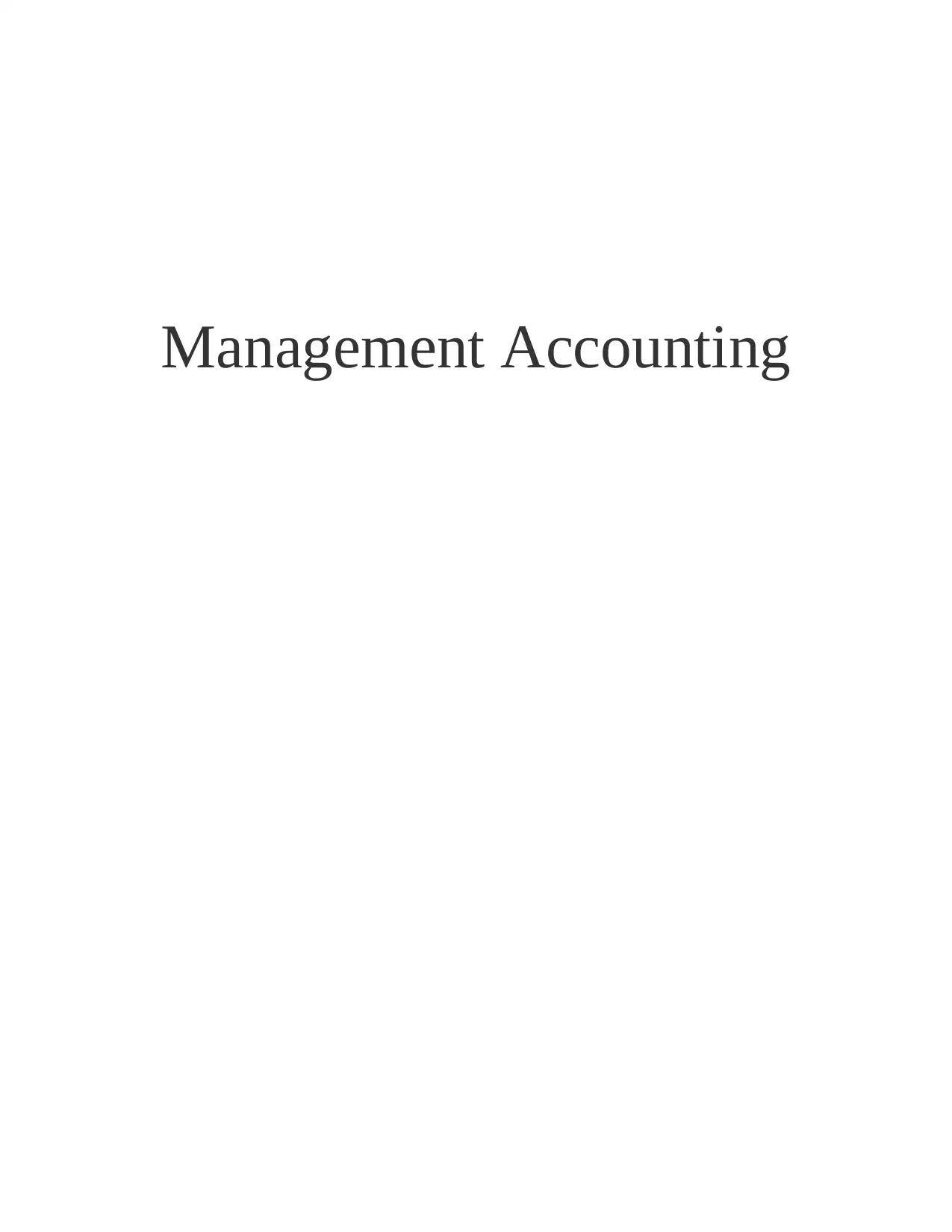
Management Accounting
Paraphrase This Document
Need a fresh take? Get an instant paraphrase of this document with our AI Paraphraser
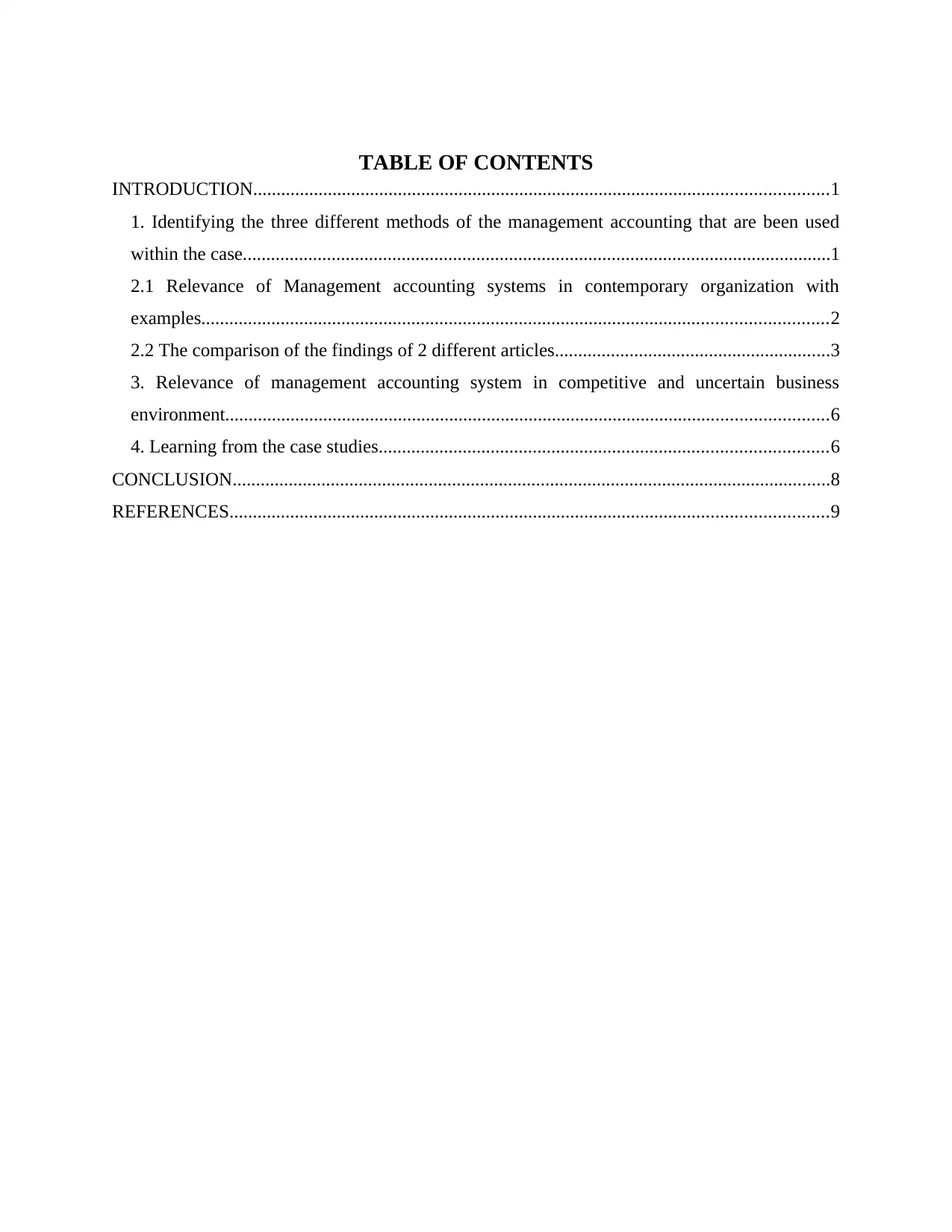
TABLE OF CONTENTS
INTRODUCTION...........................................................................................................................1
1. Identifying the three different methods of the management accounting that are been used
within the case..............................................................................................................................1
2.1 Relevance of Management accounting systems in contemporary organization with
examples......................................................................................................................................2
2.2 The comparison of the findings of 2 different articles...........................................................3
3. Relevance of management accounting system in competitive and uncertain business
environment.................................................................................................................................6
4. Learning from the case studies................................................................................................6
CONCLUSION................................................................................................................................8
REFERENCES................................................................................................................................9
INTRODUCTION...........................................................................................................................1
1. Identifying the three different methods of the management accounting that are been used
within the case..............................................................................................................................1
2.1 Relevance of Management accounting systems in contemporary organization with
examples......................................................................................................................................2
2.2 The comparison of the findings of 2 different articles...........................................................3
3. Relevance of management accounting system in competitive and uncertain business
environment.................................................................................................................................6
4. Learning from the case studies................................................................................................6
CONCLUSION................................................................................................................................8
REFERENCES................................................................................................................................9
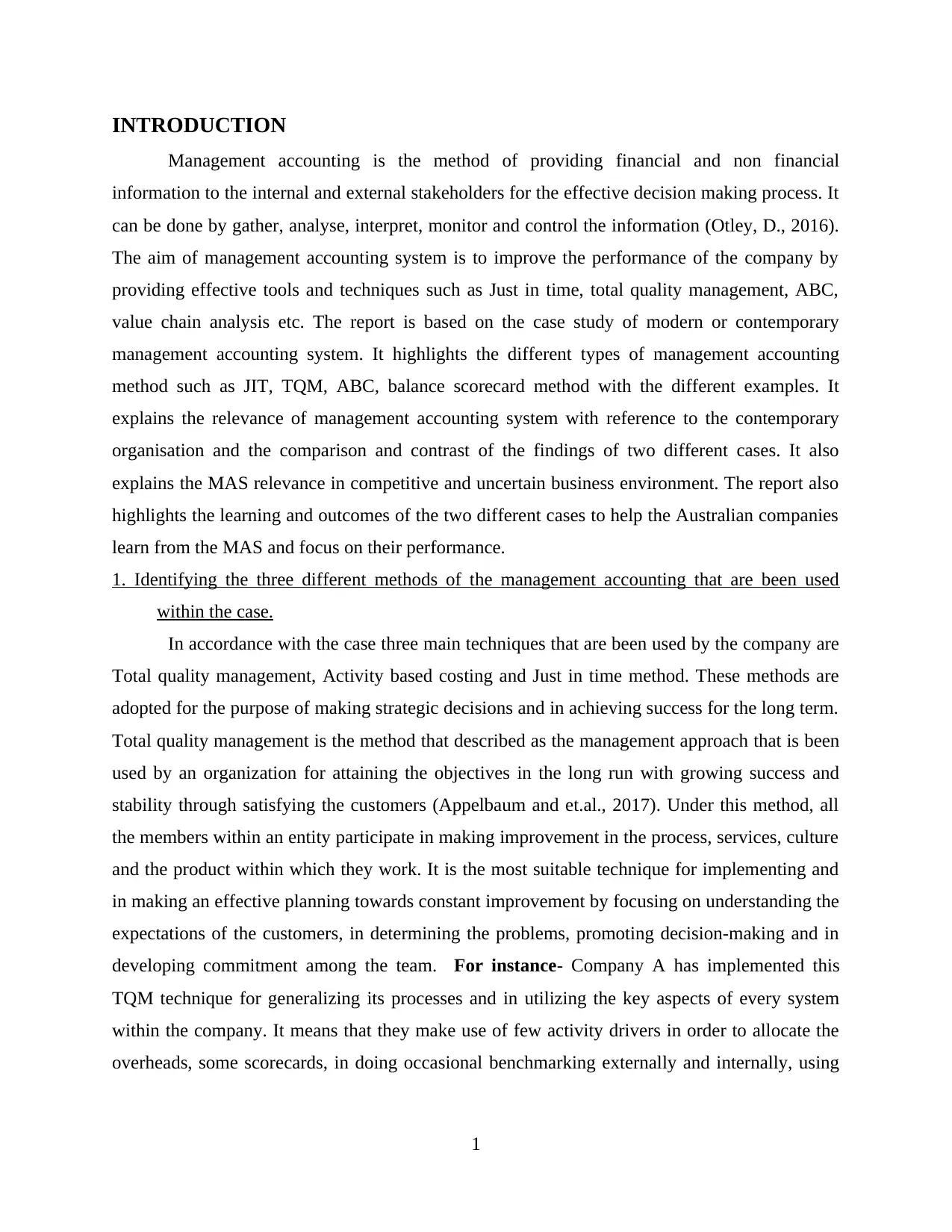
INTRODUCTION
Management accounting is the method of providing financial and non financial
information to the internal and external stakeholders for the effective decision making process. It
can be done by gather, analyse, interpret, monitor and control the information (Otley, D., 2016).
The aim of management accounting system is to improve the performance of the company by
providing effective tools and techniques such as Just in time, total quality management, ABC,
value chain analysis etc. The report is based on the case study of modern or contemporary
management accounting system. It highlights the different types of management accounting
method such as JIT, TQM, ABC, balance scorecard method with the different examples. It
explains the relevance of management accounting system with reference to the contemporary
organisation and the comparison and contrast of the findings of two different cases. It also
explains the MAS relevance in competitive and uncertain business environment. The report also
highlights the learning and outcomes of the two different cases to help the Australian companies
learn from the MAS and focus on their performance.
1. Identifying the three different methods of the management accounting that are been used
within the case.
In accordance with the case three main techniques that are been used by the company are
Total quality management, Activity based costing and Just in time method. These methods are
adopted for the purpose of making strategic decisions and in achieving success for the long term.
Total quality management is the method that described as the management approach that is been
used by an organization for attaining the objectives in the long run with growing success and
stability through satisfying the customers (Appelbaum and et.al., 2017). Under this method, all
the members within an entity participate in making improvement in the process, services, culture
and the product within which they work. It is the most suitable technique for implementing and
in making an effective planning towards constant improvement by focusing on understanding the
expectations of the customers, in determining the problems, promoting decision-making and in
developing commitment among the team. For instance- Company A has implemented this
TQM technique for generalizing its processes and in utilizing the key aspects of every system
within the company. It means that they make use of few activity drivers in order to allocate the
overheads, some scorecards, in doing occasional benchmarking externally and internally, using
1
Management accounting is the method of providing financial and non financial
information to the internal and external stakeholders for the effective decision making process. It
can be done by gather, analyse, interpret, monitor and control the information (Otley, D., 2016).
The aim of management accounting system is to improve the performance of the company by
providing effective tools and techniques such as Just in time, total quality management, ABC,
value chain analysis etc. The report is based on the case study of modern or contemporary
management accounting system. It highlights the different types of management accounting
method such as JIT, TQM, ABC, balance scorecard method with the different examples. It
explains the relevance of management accounting system with reference to the contemporary
organisation and the comparison and contrast of the findings of two different cases. It also
explains the MAS relevance in competitive and uncertain business environment. The report also
highlights the learning and outcomes of the two different cases to help the Australian companies
learn from the MAS and focus on their performance.
1. Identifying the three different methods of the management accounting that are been used
within the case.
In accordance with the case three main techniques that are been used by the company are
Total quality management, Activity based costing and Just in time method. These methods are
adopted for the purpose of making strategic decisions and in achieving success for the long term.
Total quality management is the method that described as the management approach that is been
used by an organization for attaining the objectives in the long run with growing success and
stability through satisfying the customers (Appelbaum and et.al., 2017). Under this method, all
the members within an entity participate in making improvement in the process, services, culture
and the product within which they work. It is the most suitable technique for implementing and
in making an effective planning towards constant improvement by focusing on understanding the
expectations of the customers, in determining the problems, promoting decision-making and in
developing commitment among the team. For instance- Company A has implemented this
TQM technique for generalizing its processes and in utilizing the key aspects of every system
within the company. It means that they make use of few activity drivers in order to allocate the
overheads, some scorecards, in doing occasional benchmarking externally and internally, using
1
⊘ This is a preview!⊘
Do you want full access?
Subscribe today to unlock all pages.

Trusted by 1+ million students worldwide
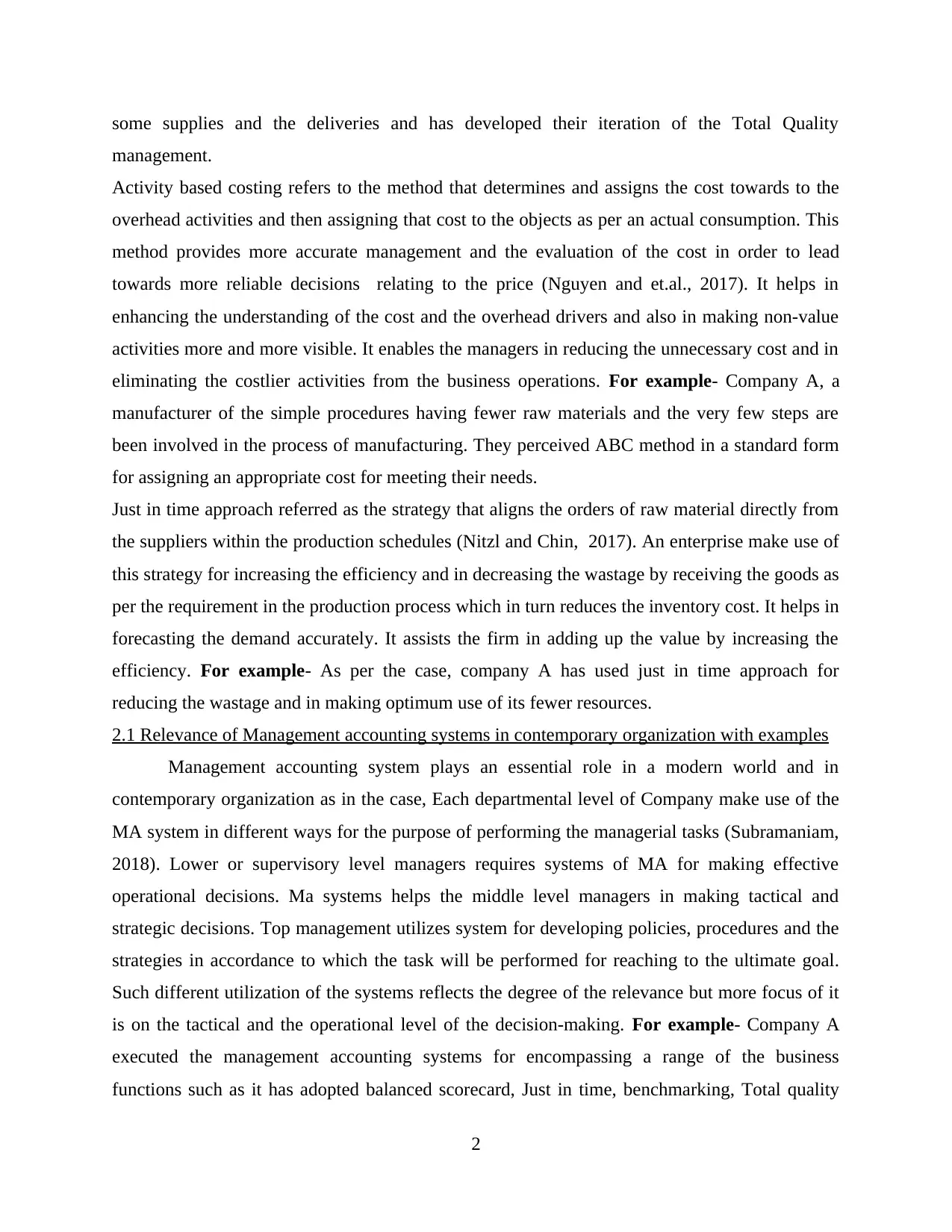
some supplies and the deliveries and has developed their iteration of the Total Quality
management.
Activity based costing refers to the method that determines and assigns the cost towards to the
overhead activities and then assigning that cost to the objects as per an actual consumption. This
method provides more accurate management and the evaluation of the cost in order to lead
towards more reliable decisions relating to the price (Nguyen and et.al., 2017). It helps in
enhancing the understanding of the cost and the overhead drivers and also in making non-value
activities more and more visible. It enables the managers in reducing the unnecessary cost and in
eliminating the costlier activities from the business operations. For example- Company A, a
manufacturer of the simple procedures having fewer raw materials and the very few steps are
been involved in the process of manufacturing. They perceived ABC method in a standard form
for assigning an appropriate cost for meeting their needs.
Just in time approach referred as the strategy that aligns the orders of raw material directly from
the suppliers within the production schedules (Nitzl and Chin, 2017). An enterprise make use of
this strategy for increasing the efficiency and in decreasing the wastage by receiving the goods as
per the requirement in the production process which in turn reduces the inventory cost. It helps in
forecasting the demand accurately. It assists the firm in adding up the value by increasing the
efficiency. For example- As per the case, company A has used just in time approach for
reducing the wastage and in making optimum use of its fewer resources.
2.1 Relevance of Management accounting systems in contemporary organization with examples
Management accounting system plays an essential role in a modern world and in
contemporary organization as in the case, Each departmental level of Company make use of the
MA system in different ways for the purpose of performing the managerial tasks (Subramaniam,
2018). Lower or supervisory level managers requires systems of MA for making effective
operational decisions. Ma systems helps the middle level managers in making tactical and
strategic decisions. Top management utilizes system for developing policies, procedures and the
strategies in accordance to which the task will be performed for reaching to the ultimate goal.
Such different utilization of the systems reflects the degree of the relevance but more focus of it
is on the tactical and the operational level of the decision-making. For example- Company A
executed the management accounting systems for encompassing a range of the business
functions such as it has adopted balanced scorecard, Just in time, benchmarking, Total quality
2
management.
Activity based costing refers to the method that determines and assigns the cost towards to the
overhead activities and then assigning that cost to the objects as per an actual consumption. This
method provides more accurate management and the evaluation of the cost in order to lead
towards more reliable decisions relating to the price (Nguyen and et.al., 2017). It helps in
enhancing the understanding of the cost and the overhead drivers and also in making non-value
activities more and more visible. It enables the managers in reducing the unnecessary cost and in
eliminating the costlier activities from the business operations. For example- Company A, a
manufacturer of the simple procedures having fewer raw materials and the very few steps are
been involved in the process of manufacturing. They perceived ABC method in a standard form
for assigning an appropriate cost for meeting their needs.
Just in time approach referred as the strategy that aligns the orders of raw material directly from
the suppliers within the production schedules (Nitzl and Chin, 2017). An enterprise make use of
this strategy for increasing the efficiency and in decreasing the wastage by receiving the goods as
per the requirement in the production process which in turn reduces the inventory cost. It helps in
forecasting the demand accurately. It assists the firm in adding up the value by increasing the
efficiency. For example- As per the case, company A has used just in time approach for
reducing the wastage and in making optimum use of its fewer resources.
2.1 Relevance of Management accounting systems in contemporary organization with examples
Management accounting system plays an essential role in a modern world and in
contemporary organization as in the case, Each departmental level of Company make use of the
MA system in different ways for the purpose of performing the managerial tasks (Subramaniam,
2018). Lower or supervisory level managers requires systems of MA for making effective
operational decisions. Ma systems helps the middle level managers in making tactical and
strategic decisions. Top management utilizes system for developing policies, procedures and the
strategies in accordance to which the task will be performed for reaching to the ultimate goal.
Such different utilization of the systems reflects the degree of the relevance but more focus of it
is on the tactical and the operational level of the decision-making. For example- Company A
executed the management accounting systems for encompassing a range of the business
functions such as it has adopted balanced scorecard, Just in time, benchmarking, Total quality
2
Paraphrase This Document
Need a fresh take? Get an instant paraphrase of this document with our AI Paraphraser
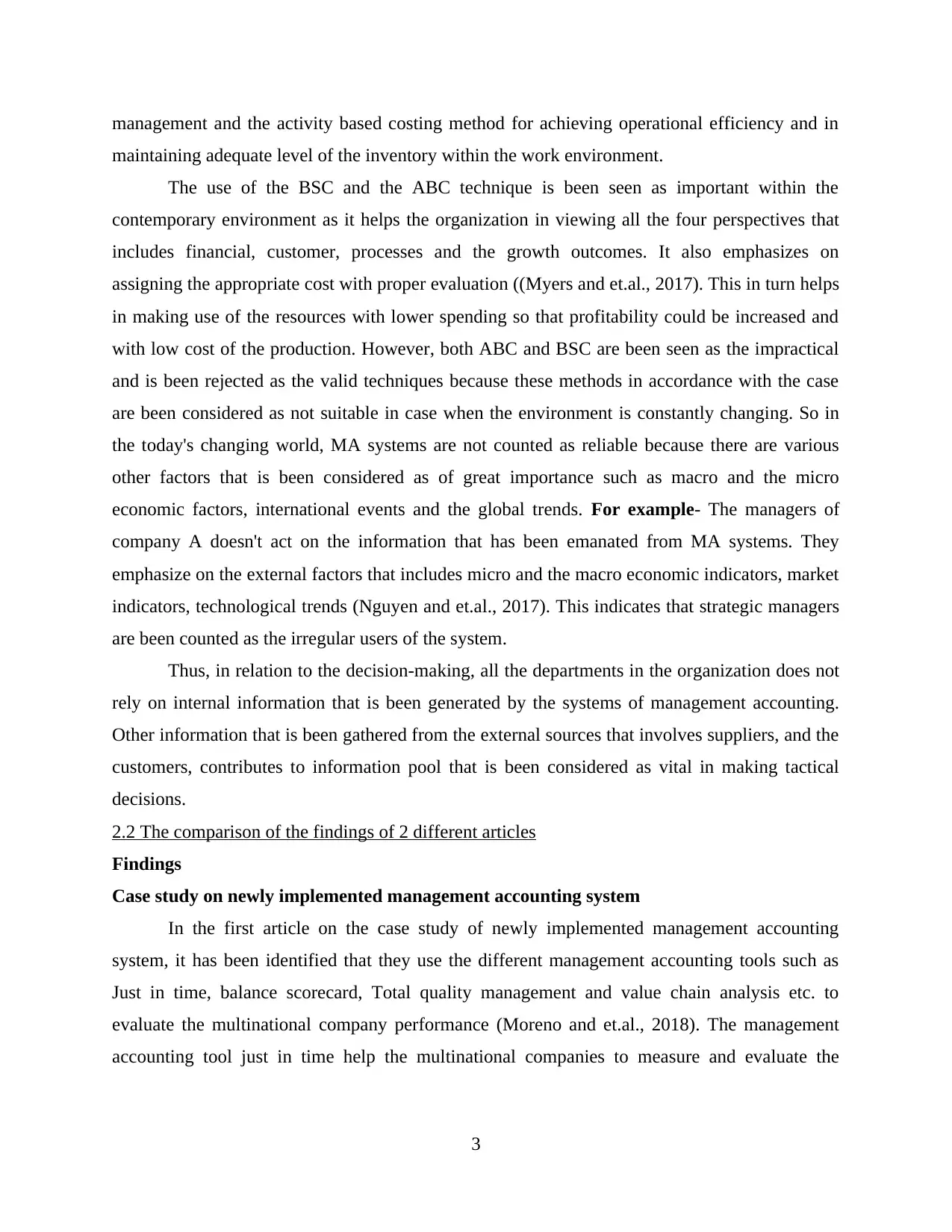
management and the activity based costing method for achieving operational efficiency and in
maintaining adequate level of the inventory within the work environment.
The use of the BSC and the ABC technique is been seen as important within the
contemporary environment as it helps the organization in viewing all the four perspectives that
includes financial, customer, processes and the growth outcomes. It also emphasizes on
assigning the appropriate cost with proper evaluation ((Myers and et.al., 2017). This in turn helps
in making use of the resources with lower spending so that profitability could be increased and
with low cost of the production. However, both ABC and BSC are been seen as the impractical
and is been rejected as the valid techniques because these methods in accordance with the case
are been considered as not suitable in case when the environment is constantly changing. So in
the today's changing world, MA systems are not counted as reliable because there are various
other factors that is been considered as of great importance such as macro and the micro
economic factors, international events and the global trends. For example- The managers of
company A doesn't act on the information that has been emanated from MA systems. They
emphasize on the external factors that includes micro and the macro economic indicators, market
indicators, technological trends (Nguyen and et.al., 2017). This indicates that strategic managers
are been counted as the irregular users of the system.
Thus, in relation to the decision-making, all the departments in the organization does not
rely on internal information that is been generated by the systems of management accounting.
Other information that is been gathered from the external sources that involves suppliers, and the
customers, contributes to information pool that is been considered as vital in making tactical
decisions.
2.2 The comparison of the findings of 2 different articles
Findings
Case study on newly implemented management accounting system
In the first article on the case study of newly implemented management accounting
system, it has been identified that they use the different management accounting tools such as
Just in time, balance scorecard, Total quality management and value chain analysis etc. to
evaluate the multinational company performance (Moreno and et.al., 2018). The management
accounting tool just in time help the multinational companies to measure and evaluate the
3
maintaining adequate level of the inventory within the work environment.
The use of the BSC and the ABC technique is been seen as important within the
contemporary environment as it helps the organization in viewing all the four perspectives that
includes financial, customer, processes and the growth outcomes. It also emphasizes on
assigning the appropriate cost with proper evaluation ((Myers and et.al., 2017). This in turn helps
in making use of the resources with lower spending so that profitability could be increased and
with low cost of the production. However, both ABC and BSC are been seen as the impractical
and is been rejected as the valid techniques because these methods in accordance with the case
are been considered as not suitable in case when the environment is constantly changing. So in
the today's changing world, MA systems are not counted as reliable because there are various
other factors that is been considered as of great importance such as macro and the micro
economic factors, international events and the global trends. For example- The managers of
company A doesn't act on the information that has been emanated from MA systems. They
emphasize on the external factors that includes micro and the macro economic indicators, market
indicators, technological trends (Nguyen and et.al., 2017). This indicates that strategic managers
are been counted as the irregular users of the system.
Thus, in relation to the decision-making, all the departments in the organization does not
rely on internal information that is been generated by the systems of management accounting.
Other information that is been gathered from the external sources that involves suppliers, and the
customers, contributes to information pool that is been considered as vital in making tactical
decisions.
2.2 The comparison of the findings of 2 different articles
Findings
Case study on newly implemented management accounting system
In the first article on the case study of newly implemented management accounting
system, it has been identified that they use the different management accounting tools such as
Just in time, balance scorecard, Total quality management and value chain analysis etc. to
evaluate the multinational company performance (Moreno and et.al., 2018). The management
accounting tool just in time help the multinational companies to measure and evaluate the
3
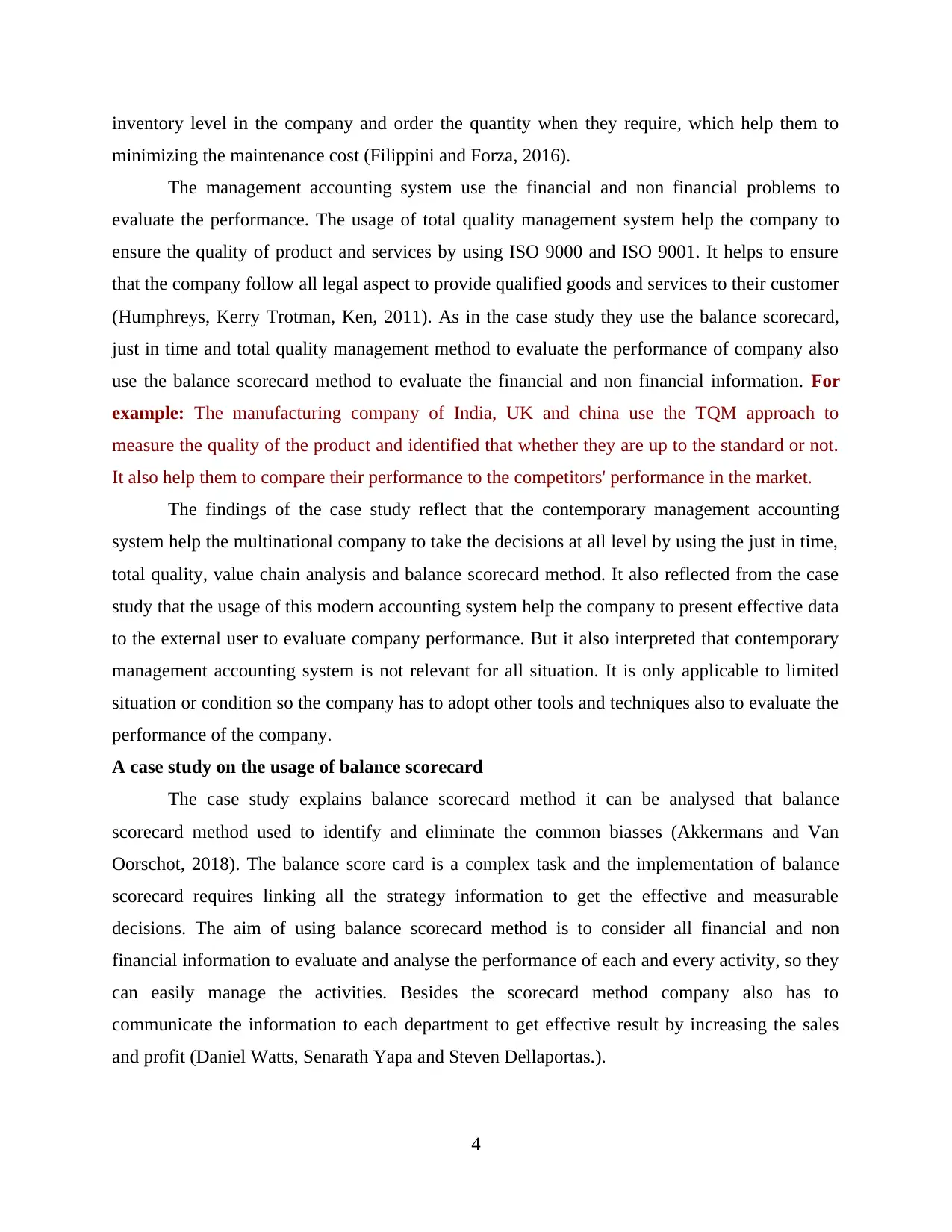
inventory level in the company and order the quantity when they require, which help them to
minimizing the maintenance cost (Filippini and Forza, 2016).
The management accounting system use the financial and non financial problems to
evaluate the performance. The usage of total quality management system help the company to
ensure the quality of product and services by using ISO 9000 and ISO 9001. It helps to ensure
that the company follow all legal aspect to provide qualified goods and services to their customer
(Humphreys, Kerry Trotman, Ken, 2011). As in the case study they use the balance scorecard,
just in time and total quality management method to evaluate the performance of company also
use the balance scorecard method to evaluate the financial and non financial information. For
example: The manufacturing company of India, UK and china use the TQM approach to
measure the quality of the product and identified that whether they are up to the standard or not.
It also help them to compare their performance to the competitors' performance in the market.
The findings of the case study reflect that the contemporary management accounting
system help the multinational company to take the decisions at all level by using the just in time,
total quality, value chain analysis and balance scorecard method. It also reflected from the case
study that the usage of this modern accounting system help the company to present effective data
to the external user to evaluate company performance. But it also interpreted that contemporary
management accounting system is not relevant for all situation. It is only applicable to limited
situation or condition so the company has to adopt other tools and techniques also to evaluate the
performance of the company.
A case study on the usage of balance scorecard
The case study explains balance scorecard method it can be analysed that balance
scorecard method used to identify and eliminate the common biasses (Akkermans and Van
Oorschot, 2018). The balance score card is a complex task and the implementation of balance
scorecard requires linking all the strategy information to get the effective and measurable
decisions. The aim of using balance scorecard method is to consider all financial and non
financial information to evaluate and analyse the performance of each and every activity, so they
can easily manage the activities. Besides the scorecard method company also has to
communicate the information to each department to get effective result by increasing the sales
and profit (Daniel Watts, Senarath Yapa and Steven Dellaportas.).
4
minimizing the maintenance cost (Filippini and Forza, 2016).
The management accounting system use the financial and non financial problems to
evaluate the performance. The usage of total quality management system help the company to
ensure the quality of product and services by using ISO 9000 and ISO 9001. It helps to ensure
that the company follow all legal aspect to provide qualified goods and services to their customer
(Humphreys, Kerry Trotman, Ken, 2011). As in the case study they use the balance scorecard,
just in time and total quality management method to evaluate the performance of company also
use the balance scorecard method to evaluate the financial and non financial information. For
example: The manufacturing company of India, UK and china use the TQM approach to
measure the quality of the product and identified that whether they are up to the standard or not.
It also help them to compare their performance to the competitors' performance in the market.
The findings of the case study reflect that the contemporary management accounting
system help the multinational company to take the decisions at all level by using the just in time,
total quality, value chain analysis and balance scorecard method. It also reflected from the case
study that the usage of this modern accounting system help the company to present effective data
to the external user to evaluate company performance. But it also interpreted that contemporary
management accounting system is not relevant for all situation. It is only applicable to limited
situation or condition so the company has to adopt other tools and techniques also to evaluate the
performance of the company.
A case study on the usage of balance scorecard
The case study explains balance scorecard method it can be analysed that balance
scorecard method used to identify and eliminate the common biasses (Akkermans and Van
Oorschot, 2018). The balance score card is a complex task and the implementation of balance
scorecard requires linking all the strategy information to get the effective and measurable
decisions. The aim of using balance scorecard method is to consider all financial and non
financial information to evaluate and analyse the performance of each and every activity, so they
can easily manage the activities. Besides the scorecard method company also has to
communicate the information to each department to get effective result by increasing the sales
and profit (Daniel Watts, Senarath Yapa and Steven Dellaportas.).
4
⊘ This is a preview!⊘
Do you want full access?
Subscribe today to unlock all pages.

Trusted by 1+ million students worldwide
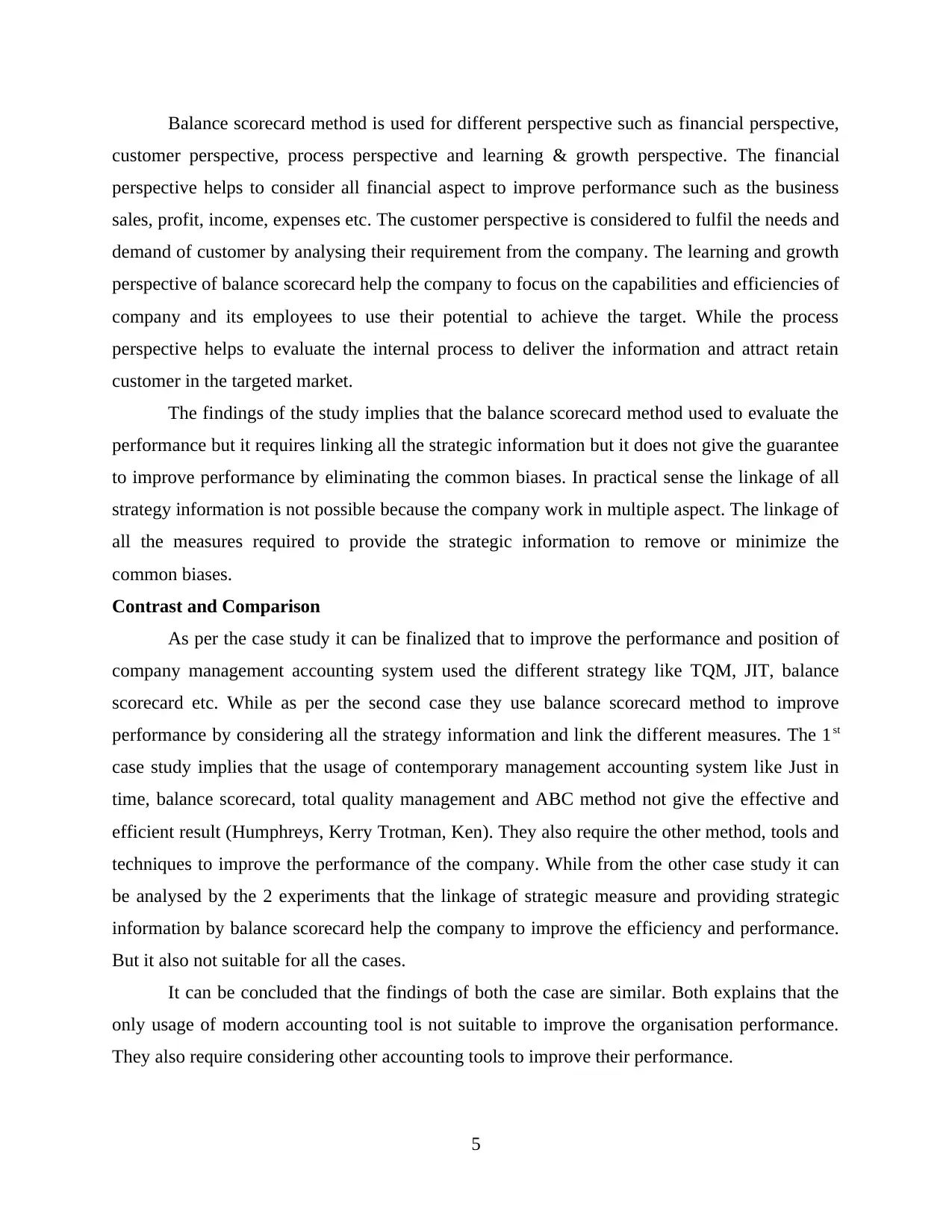
Balance scorecard method is used for different perspective such as financial perspective,
customer perspective, process perspective and learning & growth perspective. The financial
perspective helps to consider all financial aspect to improve performance such as the business
sales, profit, income, expenses etc. The customer perspective is considered to fulfil the needs and
demand of customer by analysing their requirement from the company. The learning and growth
perspective of balance scorecard help the company to focus on the capabilities and efficiencies of
company and its employees to use their potential to achieve the target. While the process
perspective helps to evaluate the internal process to deliver the information and attract retain
customer in the targeted market.
The findings of the study implies that the balance scorecard method used to evaluate the
performance but it requires linking all the strategic information but it does not give the guarantee
to improve performance by eliminating the common biases. In practical sense the linkage of all
strategy information is not possible because the company work in multiple aspect. The linkage of
all the measures required to provide the strategic information to remove or minimize the
common biases.
Contrast and Comparison
As per the case study it can be finalized that to improve the performance and position of
company management accounting system used the different strategy like TQM, JIT, balance
scorecard etc. While as per the second case they use balance scorecard method to improve
performance by considering all the strategy information and link the different measures. The 1st
case study implies that the usage of contemporary management accounting system like Just in
time, balance scorecard, total quality management and ABC method not give the effective and
efficient result (Humphreys, Kerry Trotman, Ken). They also require the other method, tools and
techniques to improve the performance of the company. While from the other case study it can
be analysed by the 2 experiments that the linkage of strategic measure and providing strategic
information by balance scorecard help the company to improve the efficiency and performance.
But it also not suitable for all the cases.
It can be concluded that the findings of both the case are similar. Both explains that the
only usage of modern accounting tool is not suitable to improve the organisation performance.
They also require considering other accounting tools to improve their performance.
5
customer perspective, process perspective and learning & growth perspective. The financial
perspective helps to consider all financial aspect to improve performance such as the business
sales, profit, income, expenses etc. The customer perspective is considered to fulfil the needs and
demand of customer by analysing their requirement from the company. The learning and growth
perspective of balance scorecard help the company to focus on the capabilities and efficiencies of
company and its employees to use their potential to achieve the target. While the process
perspective helps to evaluate the internal process to deliver the information and attract retain
customer in the targeted market.
The findings of the study implies that the balance scorecard method used to evaluate the
performance but it requires linking all the strategic information but it does not give the guarantee
to improve performance by eliminating the common biases. In practical sense the linkage of all
strategy information is not possible because the company work in multiple aspect. The linkage of
all the measures required to provide the strategic information to remove or minimize the
common biases.
Contrast and Comparison
As per the case study it can be finalized that to improve the performance and position of
company management accounting system used the different strategy like TQM, JIT, balance
scorecard etc. While as per the second case they use balance scorecard method to improve
performance by considering all the strategy information and link the different measures. The 1st
case study implies that the usage of contemporary management accounting system like Just in
time, balance scorecard, total quality management and ABC method not give the effective and
efficient result (Humphreys, Kerry Trotman, Ken). They also require the other method, tools and
techniques to improve the performance of the company. While from the other case study it can
be analysed by the 2 experiments that the linkage of strategic measure and providing strategic
information by balance scorecard help the company to improve the efficiency and performance.
But it also not suitable for all the cases.
It can be concluded that the findings of both the case are similar. Both explains that the
only usage of modern accounting tool is not suitable to improve the organisation performance.
They also require considering other accounting tools to improve their performance.
5
Paraphrase This Document
Need a fresh take? Get an instant paraphrase of this document with our AI Paraphraser
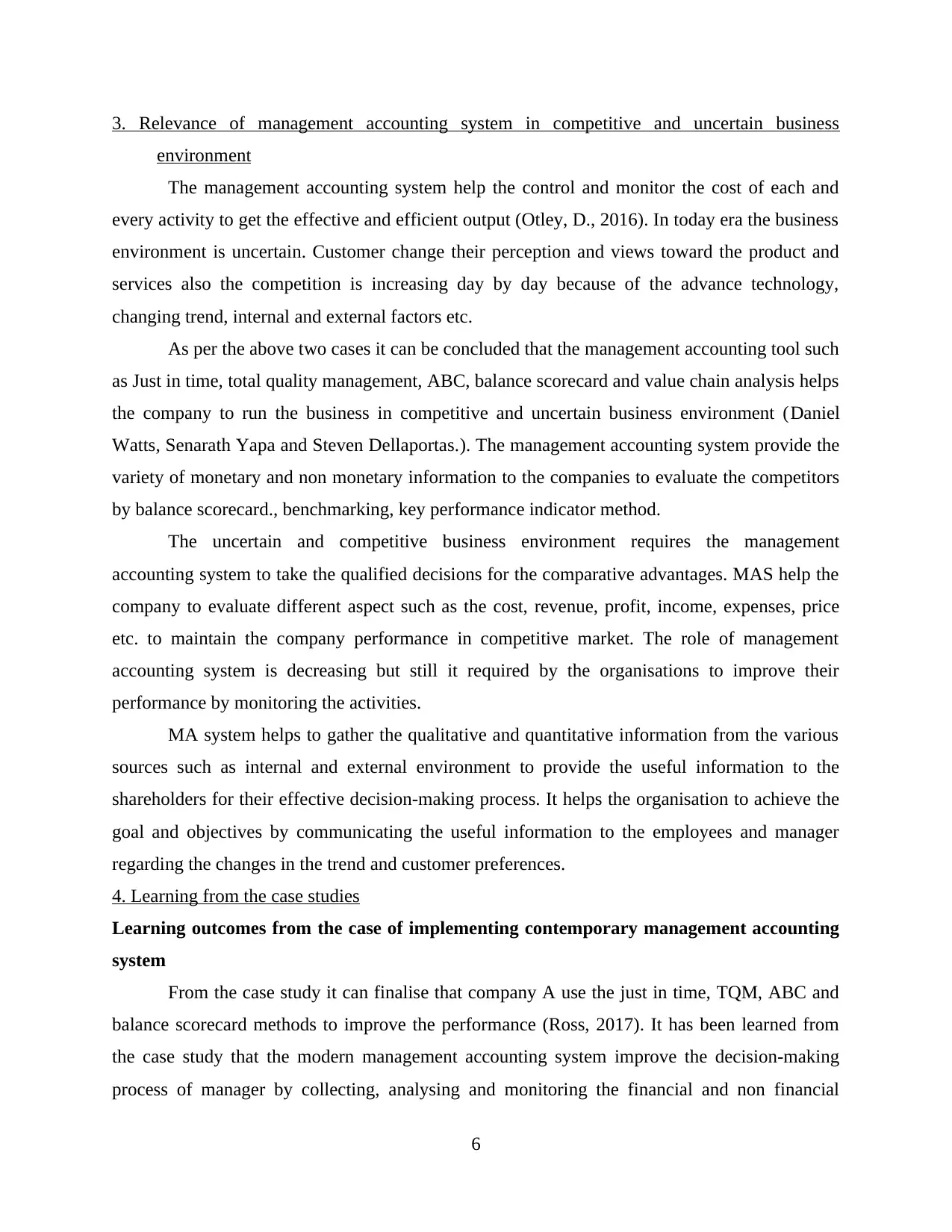
3. Relevance of management accounting system in competitive and uncertain business
environment
The management accounting system help the control and monitor the cost of each and
every activity to get the effective and efficient output (Otley, D., 2016). In today era the business
environment is uncertain. Customer change their perception and views toward the product and
services also the competition is increasing day by day because of the advance technology,
changing trend, internal and external factors etc.
As per the above two cases it can be concluded that the management accounting tool such
as Just in time, total quality management, ABC, balance scorecard and value chain analysis helps
the company to run the business in competitive and uncertain business environment (Daniel
Watts, Senarath Yapa and Steven Dellaportas.). The management accounting system provide the
variety of monetary and non monetary information to the companies to evaluate the competitors
by balance scorecard., benchmarking, key performance indicator method.
The uncertain and competitive business environment requires the management
accounting system to take the qualified decisions for the comparative advantages. MAS help the
company to evaluate different aspect such as the cost, revenue, profit, income, expenses, price
etc. to maintain the company performance in competitive market. The role of management
accounting system is decreasing but still it required by the organisations to improve their
performance by monitoring the activities.
MA system helps to gather the qualitative and quantitative information from the various
sources such as internal and external environment to provide the useful information to the
shareholders for their effective decision-making process. It helps the organisation to achieve the
goal and objectives by communicating the useful information to the employees and manager
regarding the changes in the trend and customer preferences.
4. Learning from the case studies
Learning outcomes from the case of implementing contemporary management accounting
system
From the case study it can finalise that company A use the just in time, TQM, ABC and
balance scorecard methods to improve the performance (Ross, 2017). It has been learned from
the case study that the modern management accounting system improve the decision-making
process of manager by collecting, analysing and monitoring the financial and non financial
6
environment
The management accounting system help the control and monitor the cost of each and
every activity to get the effective and efficient output (Otley, D., 2016). In today era the business
environment is uncertain. Customer change their perception and views toward the product and
services also the competition is increasing day by day because of the advance technology,
changing trend, internal and external factors etc.
As per the above two cases it can be concluded that the management accounting tool such
as Just in time, total quality management, ABC, balance scorecard and value chain analysis helps
the company to run the business in competitive and uncertain business environment (Daniel
Watts, Senarath Yapa and Steven Dellaportas.). The management accounting system provide the
variety of monetary and non monetary information to the companies to evaluate the competitors
by balance scorecard., benchmarking, key performance indicator method.
The uncertain and competitive business environment requires the management
accounting system to take the qualified decisions for the comparative advantages. MAS help the
company to evaluate different aspect such as the cost, revenue, profit, income, expenses, price
etc. to maintain the company performance in competitive market. The role of management
accounting system is decreasing but still it required by the organisations to improve their
performance by monitoring the activities.
MA system helps to gather the qualitative and quantitative information from the various
sources such as internal and external environment to provide the useful information to the
shareholders for their effective decision-making process. It helps the organisation to achieve the
goal and objectives by communicating the useful information to the employees and manager
regarding the changes in the trend and customer preferences.
4. Learning from the case studies
Learning outcomes from the case of implementing contemporary management accounting
system
From the case study it can finalise that company A use the just in time, TQM, ABC and
balance scorecard methods to improve the performance (Ross, 2017). It has been learned from
the case study that the modern management accounting system improve the decision-making
process of manager by collecting, analysing and monitoring the financial and non financial
6
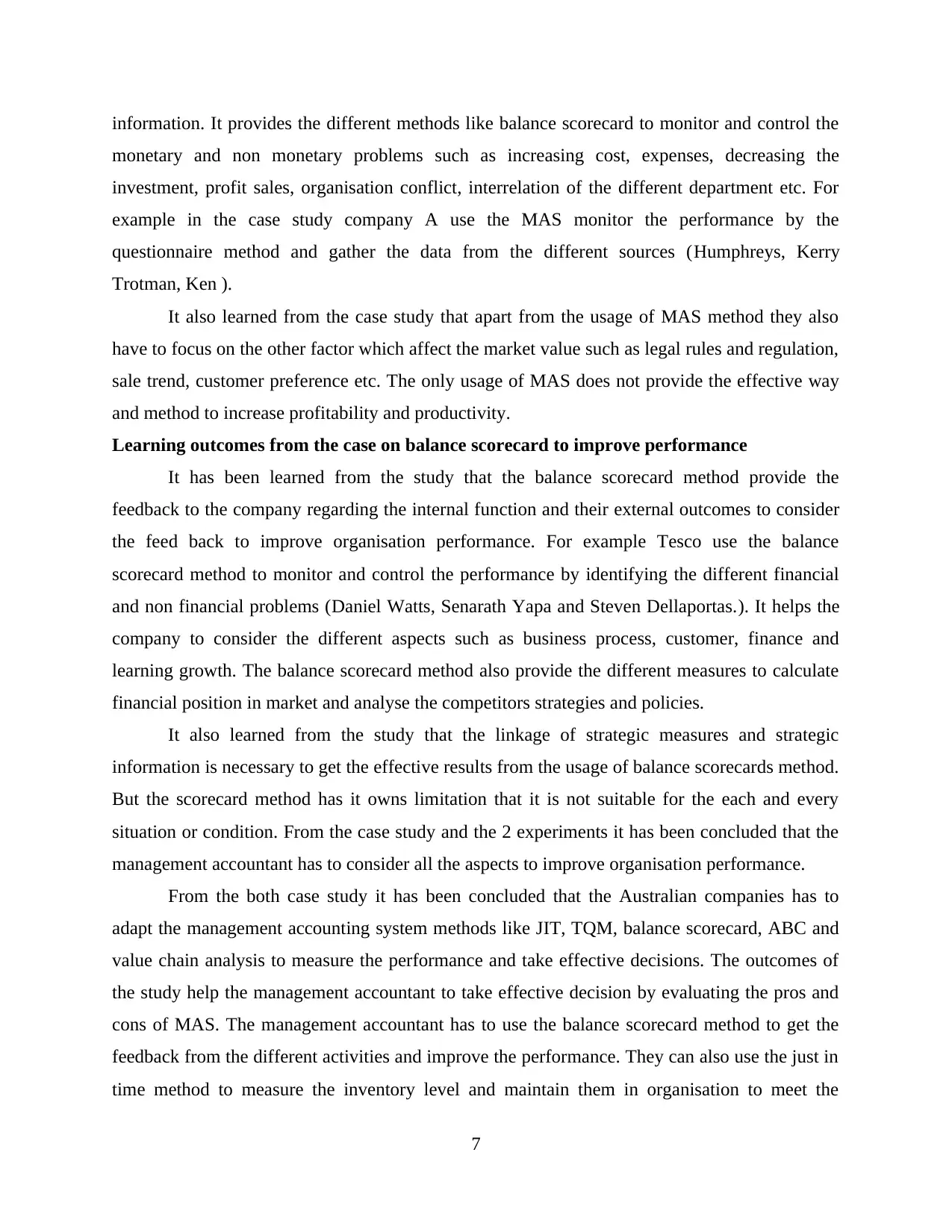
information. It provides the different methods like balance scorecard to monitor and control the
monetary and non monetary problems such as increasing cost, expenses, decreasing the
investment, profit sales, organisation conflict, interrelation of the different department etc. For
example in the case study company A use the MAS monitor the performance by the
questionnaire method and gather the data from the different sources (Humphreys, Kerry
Trotman, Ken ).
It also learned from the case study that apart from the usage of MAS method they also
have to focus on the other factor which affect the market value such as legal rules and regulation,
sale trend, customer preference etc. The only usage of MAS does not provide the effective way
and method to increase profitability and productivity.
Learning outcomes from the case on balance scorecard to improve performance
It has been learned from the study that the balance scorecard method provide the
feedback to the company regarding the internal function and their external outcomes to consider
the feed back to improve organisation performance. For example Tesco use the balance
scorecard method to monitor and control the performance by identifying the different financial
and non financial problems (Daniel Watts, Senarath Yapa and Steven Dellaportas.). It helps the
company to consider the different aspects such as business process, customer, finance and
learning growth. The balance scorecard method also provide the different measures to calculate
financial position in market and analyse the competitors strategies and policies.
It also learned from the study that the linkage of strategic measures and strategic
information is necessary to get the effective results from the usage of balance scorecards method.
But the scorecard method has it owns limitation that it is not suitable for the each and every
situation or condition. From the case study and the 2 experiments it has been concluded that the
management accountant has to consider all the aspects to improve organisation performance.
From the both case study it has been concluded that the Australian companies has to
adapt the management accounting system methods like JIT, TQM, balance scorecard, ABC and
value chain analysis to measure the performance and take effective decisions. The outcomes of
the study help the management accountant to take effective decision by evaluating the pros and
cons of MAS. The management accountant has to use the balance scorecard method to get the
feedback from the different activities and improve the performance. They can also use the just in
time method to measure the inventory level and maintain them in organisation to meet the
7
monetary and non monetary problems such as increasing cost, expenses, decreasing the
investment, profit sales, organisation conflict, interrelation of the different department etc. For
example in the case study company A use the MAS monitor the performance by the
questionnaire method and gather the data from the different sources (Humphreys, Kerry
Trotman, Ken ).
It also learned from the case study that apart from the usage of MAS method they also
have to focus on the other factor which affect the market value such as legal rules and regulation,
sale trend, customer preference etc. The only usage of MAS does not provide the effective way
and method to increase profitability and productivity.
Learning outcomes from the case on balance scorecard to improve performance
It has been learned from the study that the balance scorecard method provide the
feedback to the company regarding the internal function and their external outcomes to consider
the feed back to improve organisation performance. For example Tesco use the balance
scorecard method to monitor and control the performance by identifying the different financial
and non financial problems (Daniel Watts, Senarath Yapa and Steven Dellaportas.). It helps the
company to consider the different aspects such as business process, customer, finance and
learning growth. The balance scorecard method also provide the different measures to calculate
financial position in market and analyse the competitors strategies and policies.
It also learned from the study that the linkage of strategic measures and strategic
information is necessary to get the effective results from the usage of balance scorecards method.
But the scorecard method has it owns limitation that it is not suitable for the each and every
situation or condition. From the case study and the 2 experiments it has been concluded that the
management accountant has to consider all the aspects to improve organisation performance.
From the both case study it has been concluded that the Australian companies has to
adapt the management accounting system methods like JIT, TQM, balance scorecard, ABC and
value chain analysis to measure the performance and take effective decisions. The outcomes of
the study help the management accountant to take effective decision by evaluating the pros and
cons of MAS. The management accountant has to use the balance scorecard method to get the
feedback from the different activities and improve the performance. They can also use the just in
time method to measure the inventory level and maintain them in organisation to meet the
7
⊘ This is a preview!⊘
Do you want full access?
Subscribe today to unlock all pages.

Trusted by 1+ million students worldwide
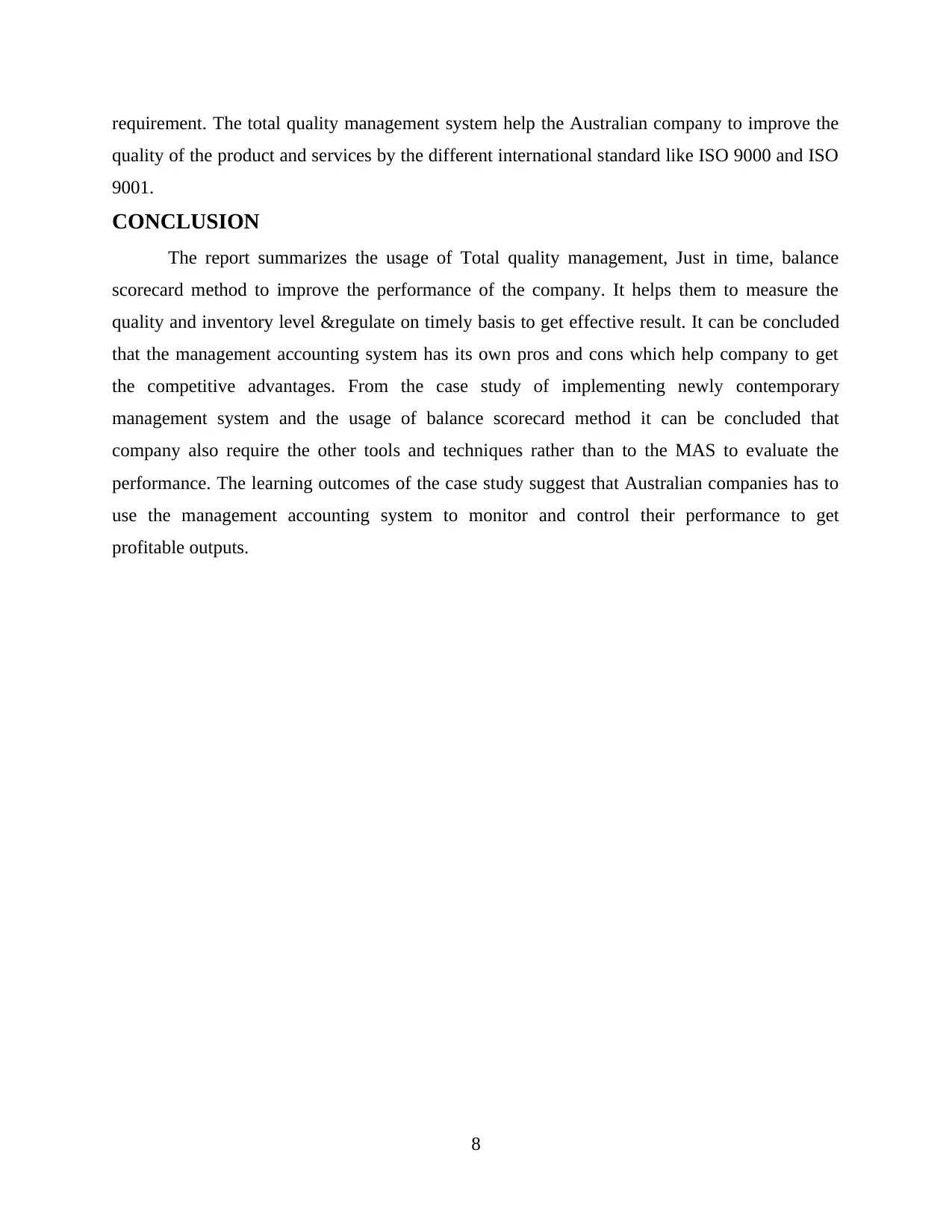
requirement. The total quality management system help the Australian company to improve the
quality of the product and services by the different international standard like ISO 9000 and ISO
9001.
CONCLUSION
The report summarizes the usage of Total quality management, Just in time, balance
scorecard method to improve the performance of the company. It helps them to measure the
quality and inventory level ®ulate on timely basis to get effective result. It can be concluded
that the management accounting system has its own pros and cons which help company to get
the competitive advantages. From the case study of implementing newly contemporary
management system and the usage of balance scorecard method it can be concluded that
company also require the other tools and techniques rather than to the MAS to evaluate the
performance. The learning outcomes of the case study suggest that Australian companies has to
use the management accounting system to monitor and control their performance to get
profitable outputs.
8
quality of the product and services by the different international standard like ISO 9000 and ISO
9001.
CONCLUSION
The report summarizes the usage of Total quality management, Just in time, balance
scorecard method to improve the performance of the company. It helps them to measure the
quality and inventory level ®ulate on timely basis to get effective result. It can be concluded
that the management accounting system has its own pros and cons which help company to get
the competitive advantages. From the case study of implementing newly contemporary
management system and the usage of balance scorecard method it can be concluded that
company also require the other tools and techniques rather than to the MAS to evaluate the
performance. The learning outcomes of the case study suggest that Australian companies has to
use the management accounting system to monitor and control their performance to get
profitable outputs.
8
Paraphrase This Document
Need a fresh take? Get an instant paraphrase of this document with our AI Paraphraser
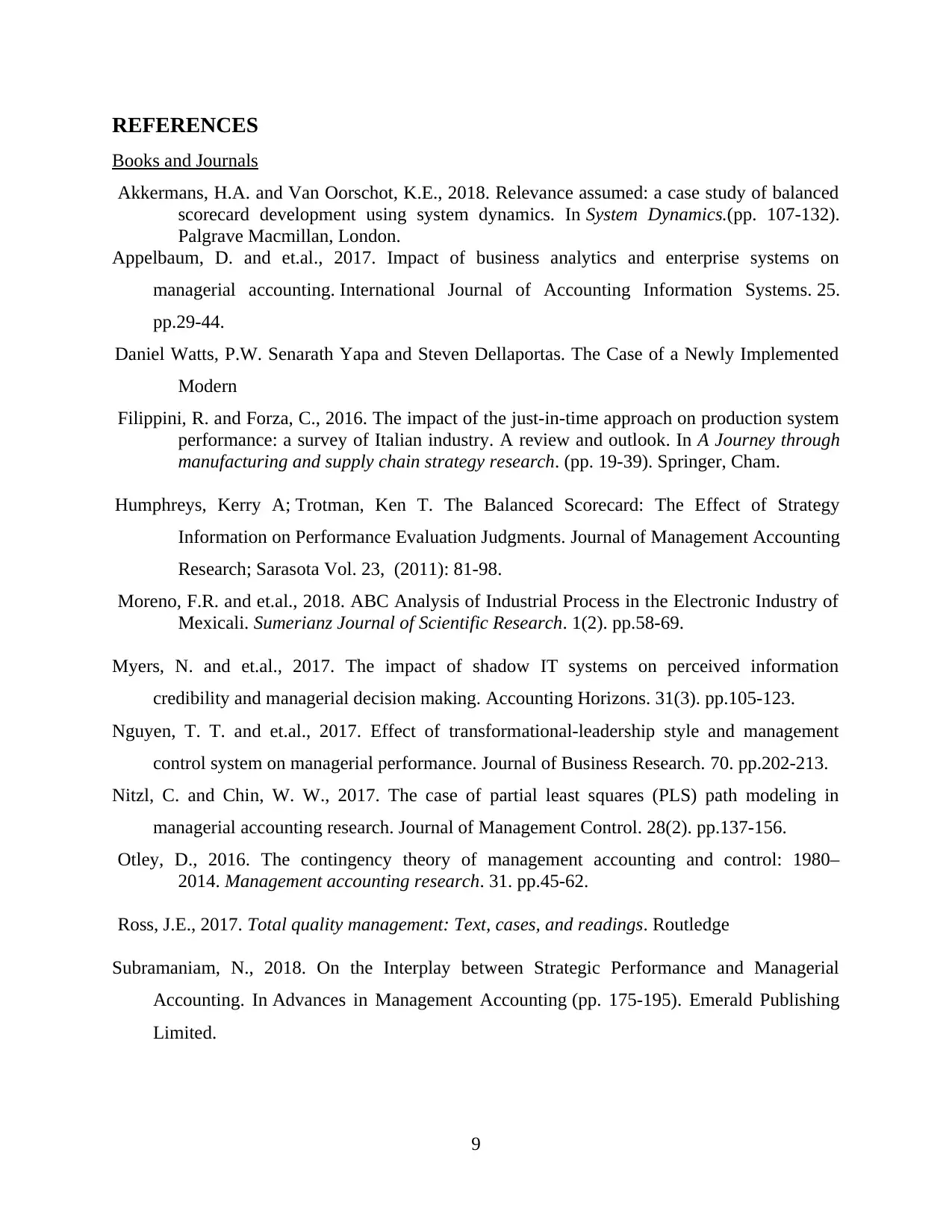
REFERENCES
Books and Journals
Akkermans, H.A. and Van Oorschot, K.E., 2018. Relevance assumed: a case study of balanced
scorecard development using system dynamics. In System Dynamics.(pp. 107-132).
Palgrave Macmillan, London.
Appelbaum, D. and et.al., 2017. Impact of business analytics and enterprise systems on
managerial accounting. International Journal of Accounting Information Systems. 25.
pp.29-44.
Daniel Watts, P.W. Senarath Yapa and Steven Dellaportas. The Case of a Newly Implemented
Modern
Filippini, R. and Forza, C., 2016. The impact of the just-in-time approach on production system
performance: a survey of Italian industry. A review and outlook. In A Journey through
manufacturing and supply chain strategy research. (pp. 19-39). Springer, Cham.
Humphreys, Kerry A; Trotman, Ken T. The Balanced Scorecard: The Effect of Strategy
Information on Performance Evaluation Judgments. Journal of Management Accounting
Research; Sarasota Vol. 23, (2011): 81-98.
Moreno, F.R. and et.al., 2018. ABC Analysis of Industrial Process in the Electronic Industry of
Mexicali. Sumerianz Journal of Scientific Research. 1(2). pp.58-69.
Myers, N. and et.al., 2017. The impact of shadow IT systems on perceived information
credibility and managerial decision making. Accounting Horizons. 31(3). pp.105-123.
Nguyen, T. T. and et.al., 2017. Effect of transformational-leadership style and management
control system on managerial performance. Journal of Business Research. 70. pp.202-213.
Nitzl, C. and Chin, W. W., 2017. The case of partial least squares (PLS) path modeling in
managerial accounting research. Journal of Management Control. 28(2). pp.137-156.
Otley, D., 2016. The contingency theory of management accounting and control: 1980–
2014. Management accounting research. 31. pp.45-62.
Ross, J.E., 2017. Total quality management: Text, cases, and readings. Routledge
Subramaniam, N., 2018. On the Interplay between Strategic Performance and Managerial
Accounting. In Advances in Management Accounting (pp. 175-195). Emerald Publishing
Limited.
9
Books and Journals
Akkermans, H.A. and Van Oorschot, K.E., 2018. Relevance assumed: a case study of balanced
scorecard development using system dynamics. In System Dynamics.(pp. 107-132).
Palgrave Macmillan, London.
Appelbaum, D. and et.al., 2017. Impact of business analytics and enterprise systems on
managerial accounting. International Journal of Accounting Information Systems. 25.
pp.29-44.
Daniel Watts, P.W. Senarath Yapa and Steven Dellaportas. The Case of a Newly Implemented
Modern
Filippini, R. and Forza, C., 2016. The impact of the just-in-time approach on production system
performance: a survey of Italian industry. A review and outlook. In A Journey through
manufacturing and supply chain strategy research. (pp. 19-39). Springer, Cham.
Humphreys, Kerry A; Trotman, Ken T. The Balanced Scorecard: The Effect of Strategy
Information on Performance Evaluation Judgments. Journal of Management Accounting
Research; Sarasota Vol. 23, (2011): 81-98.
Moreno, F.R. and et.al., 2018. ABC Analysis of Industrial Process in the Electronic Industry of
Mexicali. Sumerianz Journal of Scientific Research. 1(2). pp.58-69.
Myers, N. and et.al., 2017. The impact of shadow IT systems on perceived information
credibility and managerial decision making. Accounting Horizons. 31(3). pp.105-123.
Nguyen, T. T. and et.al., 2017. Effect of transformational-leadership style and management
control system on managerial performance. Journal of Business Research. 70. pp.202-213.
Nitzl, C. and Chin, W. W., 2017. The case of partial least squares (PLS) path modeling in
managerial accounting research. Journal of Management Control. 28(2). pp.137-156.
Otley, D., 2016. The contingency theory of management accounting and control: 1980–
2014. Management accounting research. 31. pp.45-62.
Ross, J.E., 2017. Total quality management: Text, cases, and readings. Routledge
Subramaniam, N., 2018. On the Interplay between Strategic Performance and Managerial
Accounting. In Advances in Management Accounting (pp. 175-195). Emerald Publishing
Limited.
9
1 out of 11
Related Documents
Your All-in-One AI-Powered Toolkit for Academic Success.
+13062052269
info@desklib.com
Available 24*7 on WhatsApp / Email
![[object Object]](/_next/static/media/star-bottom.7253800d.svg)
Unlock your academic potential
Copyright © 2020–2025 A2Z Services. All Rights Reserved. Developed and managed by ZUCOL.





